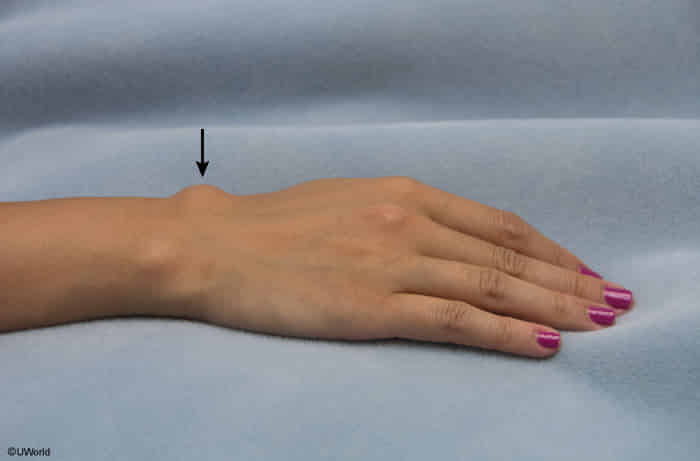- Definition: benign mucin-filled cyst that develops along tendons or joints and has no true epithelial lining
- Epidemiology: most common type of hand mass
- Location: wrist and fingers (most common at the dorsal wrist)
- Pathophysiology: herniation of connective tissue associated with repetitive trauma and mucoid degeneration of periarticular structures → sac that is lined with synovial cells and contains paucicellular connective tissue (typically mucin)
- Clinical features

- Usually asymptomatic but can occasionally cause joint pain
- Fluctuant, transilluminant swelling
- Can lead to nerve compression, which may cause numbness, weakness, or tingling (e.g., Guyon tunnel syndrome)
| Feature | Ganglion Cyst | Stenosing Tenosynovitis (Trigger/De Quervain’s) |
|---|---|---|
| Pathophysiology | Mucoid degeneration of connective tissue near a joint or tendon sheath; a fluid-filled sac without a true epithelial lining. | Inflammation/stenosis of a tendon’s synovial sheath, restricting tendon glide, often due to repetitive motion. |
| Presentation | A mobile, round, often painless subcutaneous lump, typically on the dorsal wrist. Size may fluctuate. | Trigger Finger: Painful catching, clicking, or locking of a finger during flexion. De Quervain’s: Pain/swelling on the radial wrist, worsened by thumb use. |
| Physical Exam | Firm mass that transilluminates. Fixed to deep tissue, not skin. | Trigger Finger: Tender nodule at A1 pulley (base of finger). De Quervain’s: Positive Finkelstein test (pain with ulnar deviation of fisted hand). |
| Management | 1st Line: Observation (many resolve spontaneously). 2nd Line: Aspiration (high recurrence). Definitive: Surgical excision if symptomatic. | 1st Line: Splinting, NSAIDs, activity modification. 2nd Line: Corticosteroid injection. Refractory: Surgical release of the pulley. |